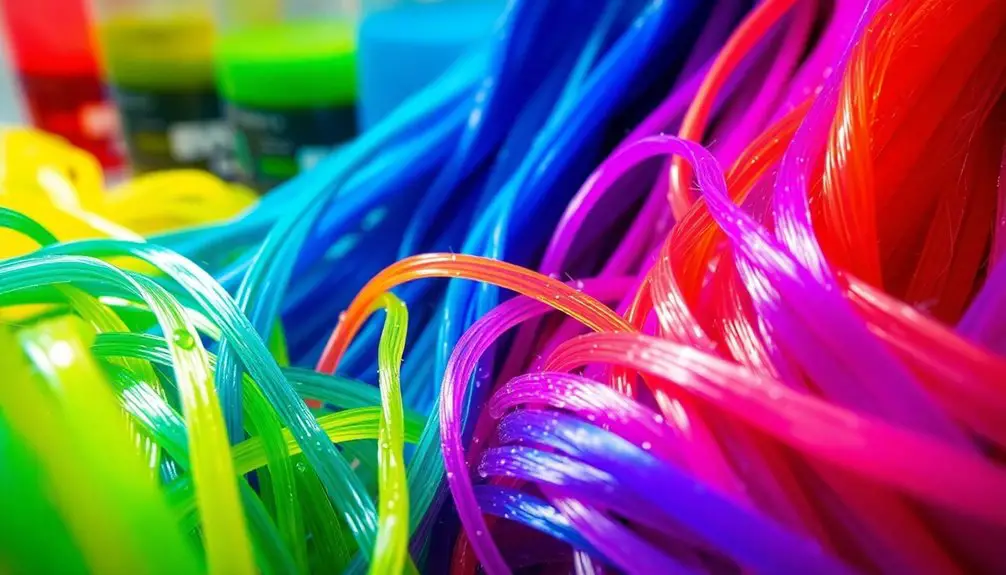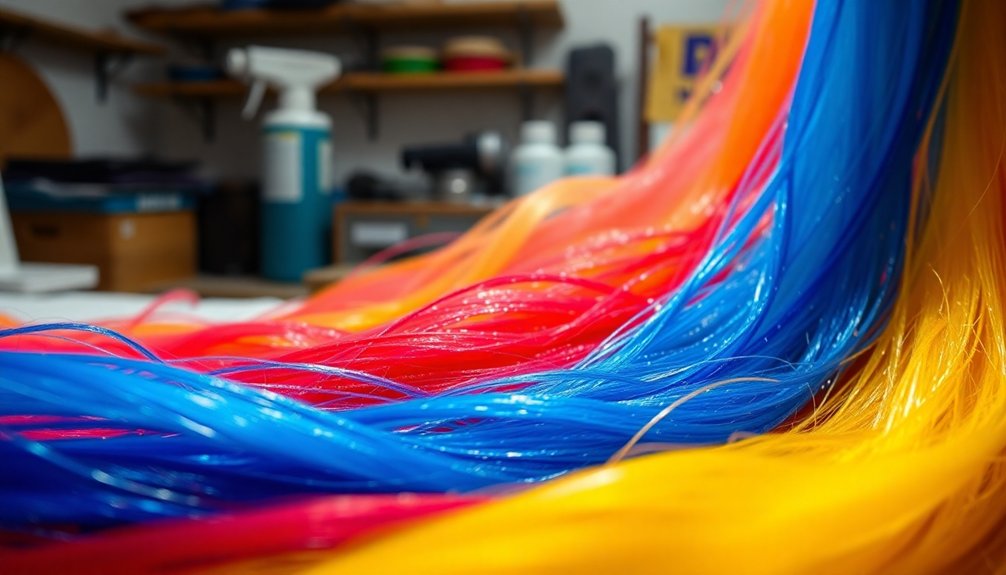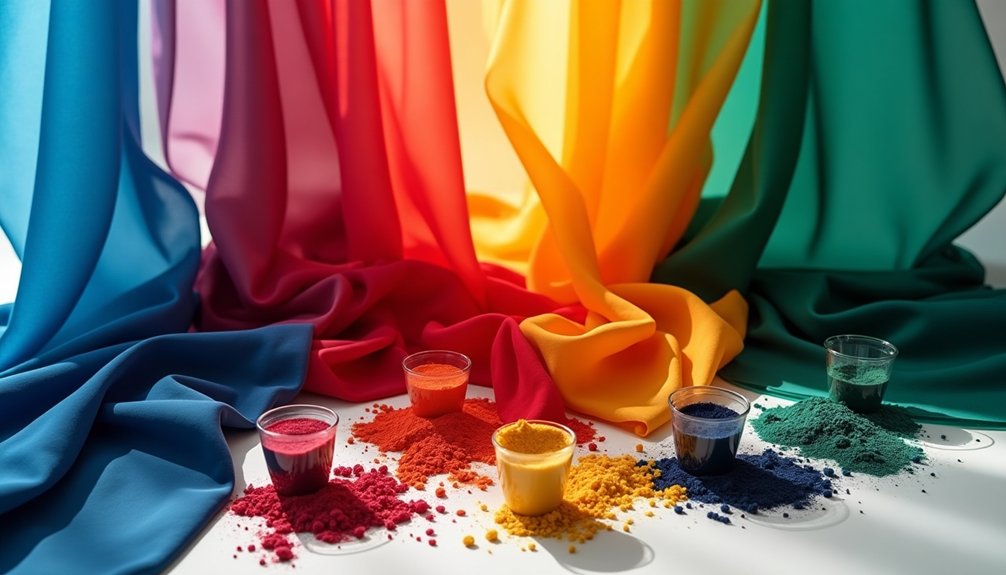Yes, you can dye polypropylene, but it isn't straightforward. The non-polar structure of polypropylene makes it challenging for dyes to bond effectively. You'll find that specific methods, like masterbatch dyeing or graft copolymerization, can enhance dyeability. Techniques like aqueous dyeing yield good color but face limitations due to the material's hydrophobicity. Also, modifying the fiber or using dye-promoting agents can improve the results. While achieving vibrant colors is possible, it's key to understand these challenges. If you explore further, you'll discover more about the best practices and techniques to get the desired results with dyed polypropylene.
Key Takeaways
- Polypropylene can be dyed, but its hydrophobic nature and non-polar structure make dyeing challenging and often less effective.
- Solution dyeing and masterbatch dyeing are effective methods for achieving solid colors but have limitations in multi-hue applications.
- High temperatures and specific dyeing agents are often required to enhance dye adhesion and promote better color uptake.
- Post-dyeing processes, including rinsing and scouring, are crucial to remove excess dye and ensure even coloration.
- Environmental concerns arise from polypropylene use, necessitating sustainable dyeing practices to mitigate plastic pollution.
Dyeing Methods
Dyeing polypropylene can be challenging due to its unique chemical structure, but several effective methods have emerged to achieve vibrant colors. One popular technique is solution dyeing, where pigments or dyes are incorporated into the hot melt during fiber extrusion. This method yields a solid color but poses challenges due to polypropylene's non-polar structure, making it hard for dyes to adhere effectively. The production of polypropylene involves various polymerization methods, including Ziegler-Natta catalysis, which affects the material's properties and dyeability.
Another method is masterbatch dyeing, where color pigments are added during the manufacturing process. This ensures an even dispersion of color throughout the material, resulting in consistent coloration, especially useful before spinning fibers into yarns or weaving them into fabric. However, it may limit you if you're looking for complex designs. Additionally, this technique enhances colorfastness and durability, which is essential for long-lasting fabrics.
Printing techniques, like digital and screen printing, offer alternatives for applying colors and designs directly onto polypropylene fabric. These methods allow for a wide range of colors and high precision, letting you achieve eye-catching results.
Lastly, aqueous dyeing processes such as pad-steam and pad-dry heat provide good color yields and help conserve water and energy, although they also face challenges due to polypropylene's high crystallinity. Each method has its advantages and limitations, so choosing the right one depends on your specific needs.
Dyeing Process
To successfully dye polypropylene, you'll need to follow a systematic dyeing process that includes several key steps.
First, prepare your dyeing solution by mixing turpentine and a surfactant. Heat this mixture to about 130°F, then add the dye until it reaches saturation, followed by water. This creates a stable micro-emulsion crucial for dyeing. Natural fabrics absorb dye better than synthetic ones, so ensure your dyeing method is suitable for the polypropylene material.
Next, immerse the polypropylene in your dyeing solution. This step can take anywhere from 10 minutes to 2 hours at temperatures up to 200°F. Keep in mind that increasing the time and temperature will enhance the color intensity, but be cautious as higher temperatures can warp molded parts.
Once the dye has penetrated the material, you need to fix it. This involves applying heat to the dyed fabric, usually in an oven, to ensure the dye bonds effectively with the fiber.
Finally, conduct post-dyeing processing by thoroughly rinsing and scouring the fiber. This step removes any excess dye and chemicals, ensuring your final product has an even color and the desired texture.
Following these steps will help you achieve successful results in dyeing polypropylene.
Challenges in Dyeing

Successfully dyeing polypropylene involves navigating various challenges that can complicate the process. One major hurdle is its hydrophobicity, which prevents aqueous dyes from penetrating the material. Additionally, the non-polar structure of polypropylene limits the ability of most dyes to bind effectively.
High crystallinity further reduces the availability of dye sites, while the lack of functional groups means there aren't enough opportunities for covalent bonding with dyes. Recent advancements in graft copolymerization have shown promise in improving dye uptake, yet practical limitations remain.
You'll also face practical limitations, such as poor uniformity in dyeing and the potential high costs of some modification methods. If you're considering blending polypropylene with other polymers, be cautious; this can decrease tensile characteristics and lead to variability in dye uptake.
Moreover, achieving uniform coloration requires additive particles to be microscopically dispersed and effectively networked within the polymer matrix.
Finally, color interference from the original fiber color can affect the dye outcome. These complexities highlight why dyeing polypropylene isn't as straightforward as with more receptive fibers, making it essential to understand these challenges before embarking on your dyeing journey.
Dye-Promoting Agents
Navigating the complexities of dyeing polypropylene can be made easier with the right dye-promoting agents. These agents help improve dye adhesion, ensuring a vibrant and uniform color. Here are some key types of dye-promoting agents you should consider:
| Type | Function |
|---|---|
| Disperse Dye Promoters | Enhance dispersing properties of disperse dyes |
| pH Adjustment Agents | Adjust pH of dye solution to optimal levels |
| Wetting Agents | Improve wetting properties of the fiber surface |
| Defoamers | Prevent foam formation during the dyeing process |
Effective dye-promoting systems like turpentine emulsion and Polycomplex G can be particularly beneficial. They work well at elevated temperatures, facilitating better dye uptake. Thorough cleaning before dyeing is crucial to prevent discoloration and enhance the overall dyeing results. Remember, the concentration of these agents can significantly affect the coloring effect; higher concentrations yield more intense colors. It's crucial that the dye is somewhat soluble in the promoting agent for successful dyeing. The surface preparation of polypropylene, including the use of low-VOC paint options, is also essential for achieving the desired color and finish. By selecting the right combination of dye-promoting agents and following best practices, you can achieve satisfying results when dyeing polypropylene.
Practical Applications

Dyeing polypropylene opens up a world of practical applications that cater to various industries. One effective method is solution dyeing, where pigments or dyes are incorporated into the hot melt, resulting in a solid color polypropylene. While this technique is great for single colors, challenges arise when you want multiple hues. However, advancements allow for dye solutions to be applied selectively to yarn, fixing the color at elevated temperatures. The use of polypropylene in various applications, including packaging and automotive, is due to its moisture resistance properties, making it a valuable material for different industries.
You can also enhance dyeability through physical modifications, like melt blending polypropylene with small amounts of polyester or polystyrene. This reduces crystallinity, allowing for better dye uptake. Notably, the incorporation of propylene molecules predominantly joining head-to-tail in the polymer chain can influence the overall dye absorption characteristics.
Chemical modifications, such as graft copolymerization, also improve dyeability by creating free radical sites on the polypropylene molecules.
For innovative applications, techniques like spin coloration apply dye solutions while fibers are still spinning, ensuring uniform coloring.
Additionally, treating polypropylene with chlorination or bromination boosts its compatibility with basic and cationic dyes. These methods not only enhance color options but can also improve light fastness, making your dyed polypropylene products both vibrant and durable.
Limitations
When it comes to dyeing polypropylene, several limitations can hinder the process and outcomes. You'll quickly notice that structural incompatibility stands as a major roadblock. Polypropylene fibers are insoluble in most chemicals, preventing effective dye penetration. This lack of dye sites means that your efforts may only result in surface staining, not the vibrant hues you desire. Additionally, the environmental concerns of polypropylene, including its role in plastic pollution, can make the dyeing process even more complex.
Additionally, dye stability is a concern. Color bleeding and susceptibility to UV degradation can leave your dyed polypropylene looking washed out over time. Practical challenges arise as well; the complex dyeing process often demands high temperatures and specific chemicals, which can be costly.
Here's a quick overview of some key limitations:
| Limitation | Impact |
|---|---|
| Structural Incompatibility | Poor dye penetration and staining only |
| Dye Stability | Color fading and bleeding over time |
| Practical Challenges | High cost and complex processes |
| Environmental Impact | Pollution and waste management issues |
These factors make dyeing polypropylene a frustrating endeavor, often leading to disappointing results.
Frequently Asked Questions
What Types of Dyes Work Best for Polypropylene?
For polypropylene, disperse dyes work best, especially C-18 dye. Blending with polymers like polyester or using chemical modifications can enhance dye uptake. Experimenting with these methods will yield vibrant, lasting colors for your projects.
Can I Dye Polypropylene at Home Easily?
Dyeing polypropylene at home isn't easy. You'll face challenges like high temperatures, long immersion times, and potential warping. While some methods exist, they require careful handling and specialized materials for effective results.
Is Dyeing Polypropylene Environmentally Friendly?
Dyeing polypropylene isn't environmentally friendly. It uses toxic chemicals, consumes large amounts of water, and creates harmful wastewater. You'll need to consider these impacts before deciding to dye polypropylene in any capacity.
How Does Dyeing Affect Polypropylene's Physical Properties?
Dyeing polypropylene can alter its physical properties significantly. You'll notice changes in tensile strength and impact resistance, depending on the dyeing method and additives used, which might affect its overall performance in applications.
Can Dyed Polypropylene Be Washed Without Losing Color?
Yes, you can wash dyed polypropylene without losing color. Its moisture resistance and ability to retain pigments ensure that cleaning methods like hosing or steam cleaning won't fade the colors, keeping your items looking vibrant.

